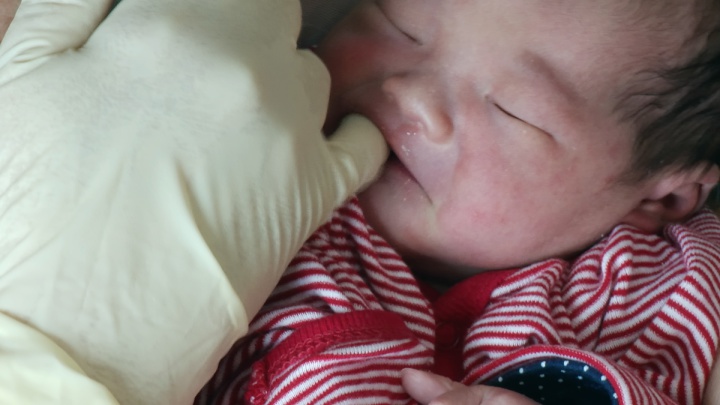Sugar Treatment Cuts Risks For Newborn Babies In NZ-Australia Trial
Rubbing sugar gel inside the mouths of newborn babies at risk of hypoglycaemia reduced their odds of developing the disorder, a four-year trial conducted in maternity hospitals across New Zealand and Australia has found.

Sugar gel demonstration
The research is important because hypoglycaemia (low blood sugar) in newborns can damage the development of a child’s brain and has been associated with diminished educational attainment.
The study by the University of Auckland’s Liggins Institute focused on babies who were at risk of hypoglycaemia from being born preterm, of high or low birthweight, or to mothers with diabetes.
The randomised controlled trial – the ‘gold standard’ of scientific investigation – took place across 18 maternity hospitals in New Zealand and Australia, with 2,149 babies receiving either a dextrose (sugar) gel or a placebo. For every 21 babies treated with the gel, one avoided hypoglycaemia. Funded by the Health Research Council, the study was led by Distinguished Professor Jane Harding and published this week in the international journal PLOS Medicine.
Sugar gel is already used to treat babies who have developed low blood sugar levels, as a result of the breakthrough 2013 ‘Sugar Babies’ study by Professor Harding and her team. The latest research explored the potential for going one step further, using the gel to prevent babies developing the problem in the first place.
“It may be time for doctors and the medical community to consider whether to adopt dextrose gel as a preventative treatment,” says Professor Harding. “We’ve shown in other studies that it’s likely to be cost-effective and may improve the baby’s later development.”
The latest trial – called hPOD, for hypoglycaemia Prevention with Oral Dextrose – ran from 2015 to 2019. A key aspect now is following up the children at ages two and six, to check on their growth and development to find out if preventing the hypoglycaemia results in better later development.
“We’re very grateful to all the families who have taken part,” says Professor Harding. “Their participation becomes even more valuable through taking part in the two and six-year follow-ups.”
While the study lowered the likelihood of hypoglycaemia for children in the at-risk categories, it didn’t reduce admissions to neonatal intensive care units.
“We think this may be because babies who are at risk of low sugar levels are also at risk of having other problems that need extra care,” Professor Harding said in a letter to families, explaining the results of the study.
Hypoglycaemia affects up to 15 percent of newborn babies and 50 percent of those with risk factors. Even transient and treated hypoglycaemia has been associated with impaired visual-motor coordination and executive function at 4.5 years, and with poorer performance on standard school testing of literacy and mathematics at 10 years.
This highlights why prevention may be so important, Professor Harding believes.


 Adaptation Futures Conference: Adaptation Futures Conference To Bring Global Scholars And Leaders To Ōtautahi
Adaptation Futures Conference: Adaptation Futures Conference To Bring Global Scholars And Leaders To Ōtautahi Crown Infrastructure Delivery: Te Pae Christchurch Convention Centre Delivers $77 Million Boost To National Economy And Supports Over 690 Jobs
Crown Infrastructure Delivery: Te Pae Christchurch Convention Centre Delivers $77 Million Boost To National Economy And Supports Over 690 Jobs University of Auckland: Power Struggles: The Psychology Behind Workplace Energy Use
University of Auckland: Power Struggles: The Psychology Behind Workplace Energy Use Commerce Commission: Sharp Fine On The Way For Look Sharp After ComCom Investigation
Commerce Commission: Sharp Fine On The Way For Look Sharp After ComCom Investigation REINZ: A Steady Market With Growing Confidence
REINZ: A Steady Market With Growing Confidence The Vegan Society Aotearoa NZ: Clear Labelling Petition for Food Safety
The Vegan Society Aotearoa NZ: Clear Labelling Petition for Food Safety



